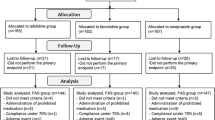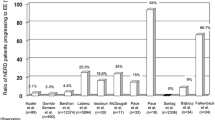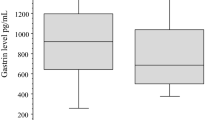Abstract
Two different doses of famotidine (20 mg twice a day versus 40 mg twice a day) were evaluated in a double-blind, randomized multicenter study in 474 symptomatic patients with erosive ulcerative reflux esophagitis. A total of 238 patients were treated with famotidine 20 mg and 236 patients with 40 mg at breakfast and dinnertime. Relief of symptoms was significant in all patients after six and 12 weeks and not different in both treatment groups. Overall endoscopic healing was significantly better in the famotidine 40 mg twice a day group compared with 20 mg twice a day at week 6 (58% versus 43%;P<0.05) and at week 12 (76% versus 67%;P<0.05). Extending treatment to 24 weeks with 40 mg of famotidine twice a day in those patients not healed after 12 weeks did not result in further symptom relief or in significantly better overall healing. The differences in efficacy of these two doses were more pronounced with increasing severity of esophagitis. Analyzed by grade of esophagitis at entrance, healing was significantly better with famotidine 40 mg twice a day at week 6 for grade II, at week 12 for grades III and IV, and at week 24 for grade IV esophagitis. The results show that in the treatment of erosive/ ulcerative reflux patients famotidine 40 mg twice a day is more effective and achieves faster healing than famotidine 20 mg twice a day.
Similar content being viewed by others
References
Koelz HR: Treatment of reflux esophagitis with H2-blockers, antacids and prokinetic drugs. Scand J Gastroenterol 156:25–36, 1989
Meuwissen SGM, Klinkenberg-Knol EC: Treatment of reflux esophagitis with H2-receptor antagonists. Scand J Gastroenterol 23:201–213, 1988
Colin-Jones DG: Histamine H2-receptor antagonists in gastro-oesophageal reflux. Gut 30:1305–1308, 1989
Koelz HR, Birchler R, Bretholz A, Bron B, Capitaine Y, Delmore G, Fehr HF, Fumagalli I, Gehrig J, Gonvers JJ, Halter F, Hammer B, Kayasseh L, Kobler, E, Miller G, Münst G, Pelloni S, Realini S, Schmid P, Voirol M, Blum A: Healing and relapse rate of reflux oesophagitis during treatment with ranitidine. Gastroenterology 91:1198–1205, 1986
Johnson NJ, Boyd EJS, Mills JG, Wood JR: Acute treatment of reflux oesophagitis: A multi-centre trial to compare 150 mg ranitidine bd with 300 mg ranitidine qds. Aliment Pharmacol Ther 3:259–266, 1989
Ruth M, Enbom H, Lundell L, Lohnroth H, Sandberg N, Sandmark S: The effect of omeprazole or ranitidine treatment on 24-hour esophageal acidity in patients with reflux esophagitis. Scand J Gastroenterol 23:1141–1146, 1988
Schaub N, Meyrick Thomas J, Misiewicz JJ, Lovell D, Trotman IF: Investigation of ranitidine 150 mg bd or 300 mg bd in the treatment of reflux disease. Hepato-Gastroenterol 33:208–213, 1986
Quik RFP, Cooper MJ, Gleeson M, Hentschel E, Schuetze K, Kingston RD, Mitchell M: A comparison of two doses of nizatidine versus placebo in the treatment of reflux oesophagitis. Aliment Pharmacol Ther 4:201–211, 1990
Havelund T, Laursen LS, Skoubo-Kristensen E, Andersen BN, Pedersen SA, Jensen KB, Fenger C, Hanberg-Sorensen F, Lauritsen K: Omeprazole and ranitidine in treatment of reflux oesophagitis: double blind comparative trial. Br Med J 296:89–92, 1988
Dehn TCB, Shepherd HA, Colin-Jones D, Kettlewell MGW, Carroll NJH: Double blind comparison of omeprazole (40 mg od) versus cimetidine (400 mg qd) in the treatment of symptomatic erosive reflux oesophagitis, assessed endoscopically, histologically and by 24 h pH-monitoring. Gut 31:509–513, 1990
Bardhan KD, Morris P, Thompson M, Dhande DS, Hinchliffe RFC, Jones RB, Daly MJ, Caroll NJH: Omeprazole in the treatment of erosive oesophagitis refractory to high dose cimetidine and ranitidine. Gut 31:745–749, 1990
Bate CM, Keeling PWN, O'Morain C, Wilkinson SP, Foster DN, Mountford RA, Temperley JM, Harvey RF, Thompson DG, Davis M, Forgnes IC, Bassett US, Richardson PDI: Comparison of omeprazole and cimetidine in reflux oesophagitis: Symptomatic, endoscopic, and histological evaluations. Gut 31:968–972, 1990
Tijtgat GNJ, Nicolai JJ, Reman FC: Efficacy of different doses of cimetidine in the treatment of reflux oesophagitis. A review of three large, double-blind, controlled trials. Gastroenterology 99:629–634, 1990
Johnsson F, Joelsson B, Gudmundsson K, Grieff L: Symptoms and endoscopic findings in the diagnosis of gastroesophageal reflux disease. Scand J Gastroenterol 22:714–718, 1987
Sonnenberg A, Lepsien G, Müller-Lissner SA, Koelz HR, Siewert JR, Blum AL: When is esophagitis healed? Esophageal endoscopy, histology, and function before and after cimetidine treatment. Dig Dis Sci 27:297–302, 1982
Tijtgat GNJ: Endoscopy of the oesophagus.In Annual of Gastrointestinal Endoscopy. PB Cotton, GNJ Tijgat, CB Williams (eds). London, Current Science, 1989, pp 9–22
Savary M, Miller G: The Esophagus. Handbook and Atlas of Endoscopy. Solothurn, Gassman, 1978
Tijtgat GNJ: Medical therapy of reflux esophagitis.In Diseases of the Esophagus. JR Siewert, AH Hölscher (eds). Heidelberg, Springer-Verlag, 1988, pp 1137–1146
Klinkenberg-Knol, Jansen JNBJ, Festen HPM, Meuwissen SGM, Lamers CBHW: Double-blind multicentre comparison of omeprazole and ranitidine in the treatment of reflux oesophagitis. Lancet 1:349–351, 1987
De Caestecker JS, Blackwell JN, Pryde A, Heading RC: Daytime gastro-oesophageal reflux is important in oesophagitis. Gut 28:519–526, 1987
Kruse-Andersen S, Wallin L, Madsen T: Reflux patterns and related oesophageal motoractivity in gastro-oesophageal reflux disease. Gut 31:633–638, 1990
De Meester TR, Wang CI, Wernly JA, Little AG, Pellegrini CA, Klementschitsch P, Bermudez G, Johnson LF, Skinner DB: Technique, indications and clinical use of 24 hour esophageal pH-monitoring. J Thorac Cardiovasc Surg 79:656–670, 1980
Jenkinson LR, Norris TL, Barlon AP, Watson A: Acid reflux and oesophagitis—day or night? Gullet 1:36–44, 1990
Pace F, Sangaletti O, Bianchi Porro G: Daytime reduction of gastro-oesophageal reflux after healing of oesophagitis and its value as an indicator of favourable response to maintenance treatment. Gut 31:1025–1029, 1990
Fiorucci S, Santucci L, Perrone E, Abbritti F, Morelli A: Gastric and esophageal acidity during continuous treatment with H2-antagonists in uncomplicated esophagitis. Scand J Gastroenterol 24:671–677, 1989
Orr WC, Robinson MC, Humphries TJ, Antonello J, Cagliola A: Dose response effects of famotidine on patterns of gastro-oesophageal reflux. Aliment Pharmacol Ther 2:229–235, 1988
Johansson KE, Tibbling L: Gastric secretion and reflux pattern in reflux oesophagitis before and during ranitidine treatment. Scand J Gastroenterol 21:487–492, 1987
Collen MJ, Lewis JH, Benjamin SB: Gastric acid hypersecretion in refractory gastroesophageal reflux disease. Gastroenterology 98:654–661, 1990
Sandmark S, Carlsson R, Fausa O, Lundell L: Omeprazole or ranitidine in the treatment of reflux esophagitis. Scand J Gastroenterol 23:625–632, 1988
Jansen JBMJ, Baak LC, Lamers CBHW: Effect of increasing doses of ranitidine on exposure of the oesophagus to gastric acid in patients with reflux oesophagitis. Scand J Gastroenterol 23(suppl 154):2–5, 1988
Howard JM, Chremos AN, Collen MJ, McArthur KE, Cherner JA, Maton PN, Ciarlegio CA, Cornelius MJ, Gardner JD, Jensen RT: Famotidine, a new, potent, long-acting histamine H2-receptor antagonist: Comparison with cimetidine and ranitidine in the treatment of Zollinger-Ellison syndrome. Gastroenterology 88:1016–1033, 1985
McCallum RW, Chremos AN, Kuljian B, Tuyp-Visich MA, Huber PB: Mk-208, a novel histamine H2-receptor antagonist inhibitor with prolonged anti-secretory effects. Dig Dis Sci 30:1139–1144, 1985
Berenson M, Simon TJ, Berlin RG, Stein DT, Roufail WM, Kogut DG, Snapinn S, Cagliola AJ, Fong C: Bid regimens of an H2-receptor antagonist heal erosive esophagitis: Results of a US, double-blind, randomized, multi-center trial. Gastroenterology 97:372A, 1990
Edge DP: High dose famotidine in ranitidine resistant severe oesophagitis: A pilot study. NZ Med J 103:150–152, 1990
Simon TJ, Berlin RG, Lipping RW, Stauffer LA, Gilde LR: Results of an international double-blind, multicenter trial comparing BID dosages of H2-receptor antagonists: Relationship between pharmacodynamic effect on esophageal reflux and healing of erosive esophagitis. Am J Gastroenterol 85:42A, 1990
Wesdorp E, Bartelsman J, Pape K, Dekker W, Tijtgat GN: Oral cimetidine in reflux esophagitis: A double blind controlled trial. Gastroenterology 74:821–824, 1978
Mann SG: The place of famotidine in anti-ulcer therapy. Aliment Pharmacol Ther 1:504–509, 1987
Hernández-Muñoz R, Caballeria J, Baraona E, Uppal R, Greenstein R, Lieber ChS: Human gastric alcohol dehydrogenase: Its inhibition by H2-receptor antagonists, and its effects on the bioavailability of ethanol. Alcohol Clin Exp Res 6:946–950, 1990
Author information
Authors and Affiliations
Additional information
for the Dutch Esophagitis Study Group.
Participating physicians: P. Batenburg, J. Beker, J. Bellaar Spruijt, L. van Bergeijk, J. Bergmann, W. Bode, J. de Boer, H. Boot, G. Dorrepaal, J. Douma, J. Drapers, J. Ferwerda, H. Festen, A. Geraedts, J. Götz, E. van der Hoek, R. van Hogezand, J. Juttmann, M. Kloppenburg, F. Lalisang, W. Lesterhuis, D. van der Linde, G. van der Linden, J. van Maanen, J. Minkema, C. Mulder, I. van Munster, J. Nadorp, G. Nelis, J. Nicolai, R. Ouwendijk, D. Overbosch, A. van der Putten, J. Raats, F. Schuitemaker, J. Sindram, G. Slagboom, P. Snel, P. Stijnen, J. Thies, J. Thijs, H. Tuynman, B. Uyterlinde, J. ten Veen, K. te Velde, M. Vidakovic-Vukic, F. Vismans, A. Vogten, G. Vosmaer, P. de Vries, H. Walinga, S. van der Werf, I. Wesdorp, B. Westerveld, A. Wolff, R. Ypma.
This study was supported by a grant from Merck Sharp & Dohme, The Netherlands.
Rights and permissions
About this article
Cite this article
Wesdorp, I.C.E., Dekker, W. & Festen, H.P.M. Efficacy of famotidine 20 mg twice a day versus 40 mg twice a day in the treatment of erosive or ulcerative reflux esophagitis. Digest Dis Sci 38, 2287–2293 (1993). https://doi.org/10.1007/BF01299910
Received:
Revised:
Accepted:
Issue Date:
DOI: https://doi.org/10.1007/BF01299910




